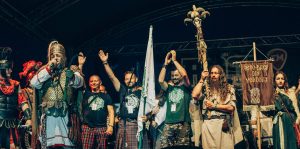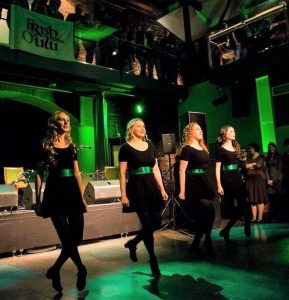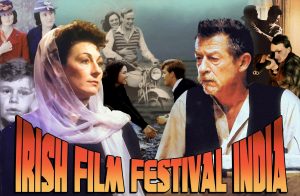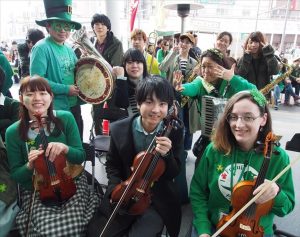
As Celtic Life International senior writer Chris Muise tells us, Celtic culture can be uncovered in all corners of the world…
I am lucky to live in Nova Scotia. I could trip and land in a celebration of Celtic culture.
It isn’t hard for folks to find a way to connect with their Irish, Scottish, and Gaelic roots here in Canada’s ocean playground. From the strong Gaelic ties in Cape Breton, to the rich shipping heritage of my hometown of Yarmouth, there is at least a little Celtic in every corner of Nova Scotia. Heck, even the name means “New Scotland.”
But the province is hardly unique in that sense. Of course, Scotland and Ireland and the rest of the United Kingdom all have their own cultural celebrations – that goes without saying. But every year, this magazine also highlights the myriad of Celtic festivals and celebrations that happen around the world. Seemingly, communities across Canada, and many pockets of the United States, have a chapter in the epic story that is the Celtic Diaspora.
But it can be easy to forget that the net of the Celtic people has been cast much wider than just North America and the U.K. It may be easy to find some Celtic history in those parts of the world, but it is also hard to find a place on this rock that hasn’t been touched by the Celtic people.
Trust me. I’ve been looking.
Readers of Celtic Life International will recognize a few examples of far-reaching celebrations of Celtic culture, as we have featured plenty of them over the years. In 2019 alone, over 51 countries around the world have, or will, host Celtic festivals of some sort, including in such unlikely spots as Brazil, Sweden, Italy, Senegal, Indonesia, Argentina, Russia, New Guinea, and many more.
The Festival Interceltique de Lorient, held in France each summer, is among the many festivals we have showcased. A southern port city in Bretagne, the country’s ancient Celtic region, the annual ten-day gathering is one of the most prominent events on the global Celtic calendar, and across Europe in particular.
Beginning in 1971 with the region’s first bagpipes festival, the festivities open with a Kaoteriad – a traditional Breton stew of seafood and potatoes topping a baguette – held in the Porzh Pesketa harbour district, with Breton music for ambiance. A huge draw is the Parade of Celtic Nations, which invites more than 3,500 artists from across the Diaspora every year.

Beyond the borders of the traditional Celtic nations, the town of Beclean in Bistrița-Năsăud County, north-eastern Transylvania, Romania, hosts a Celtic festival altogether different.
According to achealogical findings, the history of Celts in Transylvania goes back to the 4th century BC. Radu Zagreanu is a Romanian archeaologist, who also helps keep Beclean’s annual Celtic Village re-enactment portion of its Transylvanian Celtic Festival historically accurate.
“The Celts exercised politico-military rule over Transylvania between the 4th and 2nd century BC and brought with them a more advanced iron-working technology,” he explains. “Located geographically on the edge of the Celtic world, we created this concept at the festival, called the Celtic Village, a recreation of a hypothetical Celtic fair, where people from different parts of the Celtic world gather together and spend an unforgettable weekend together.”
You would be surprised where Celtic history pops up when you look hard enough. Even as far afield as Cuba and Barbados – festivals which we have also covered in depth – the celebrations make sense given the patterns of voluntary or forced emigration to the Caribbean. And while it may not be obvious, there is Celtic culture there to celebrate.
What about places where Celtic connections are few and far between?
How do people of Celtic lineage who live in more remote regions – where the Diaspora is not as prominent – honour their heritage?
With “passion, persistence, and professionality.” At least, that is how Brent Cassidy manages it.
Cassidy, an Irishman of Donegal and County Fermanagh by way of North Carolina, explains how he wound up living in Oulu, Finland, just 300 kilometres south of the Arctic Circle.
“I arrived as an exchange student back in 1997 and studied Scandinavian culture. I returned to America to get my degree, before coming back here to work as a kindergarten teacher.”
Most of Ireland’s connections to Finland in history are relatively recent – the two nations first established diplomatic relations in 1962, according to Ireland’s embassy in Finland. It’s not like they go a-ways back, like Celts in France or Spain or even North America and the Caribbean. So…what, if any, is the connection?
“I believe it is more of a mentality,” says Cassidy. “Both cultures are, in my opinion, rather relaxed. I suppose it comes from this rural culture, where the city life is still pretty new. A lot of the people in this city actually come from the countryside.”
There is another, more concrete connection: music.

“Irish music has been here for probably about 30 years,” says Cassidy, himself a musician. “When I started getting into the scene, I might have played music occasionally. But I really wanted to play music and listen to music, so I started organizing sessions. The sessions started once a month, and then they grew to twice a month. Then I decided to start a festival.”
The Irish Festival of Oulu debuted humbly in 2006, hosting about 2,000 people. It didn’t take long to catch on, however.
“It just kind of took off,” Cassidy recalls. “2007 was a really big year. We even had (renowned Irish piper) Paddy Keenan perform. Today, the gathering has evolved to include a wide range of events, including theatre, poetry, storytelling, and film.”
It’s been slower-going for Marc-Ivan O’Gorman, a Co. Carlow transplant living part-time in New Delhi with his Indian wife. Whereas Cassidy connects to people with music, O’Gorman speaks the language of cinema, which he has tried to share with his Indian neighbours.
“I was working for a TV channel there and I had been involved in film and the arts since I was a teenager, so this is always my way of interacting with other cultures,” O’Gorman explains from Los Angeles.
“I noticed that there was a real dearth of interaction, or general understanding, between Irish and Indian cultures. And I felt there was actually quite a lot of common ground there – similar experiences and attitudes to life than perhaps they were aware of. But, even just geographically, they hadn’t really explored those overlaps.
“Both countries are former British colonies that had successful national independence movements in the 20th century.”
“They kind-of bounce off each other, communicating on a sort of philosophical and cultural level.”
O’Gorman notes that most Indian people’s awareness of Ireland is through the country’s literary lineage; writers such as W.B. Yeats, George Bernard Shaw, and James Joyce. Aiming to grow that awareness, he founded the first Indian Film Festival of Ireland.
“The first iteration of the festival was picking movies that featured Irish writers, either as adaptations of plays like Dancing at Lughnasa, or adaptations of short stories like William Trevor’s Ballroom of Romance. I picked famous Irish writers, found movies that featured them, and called it The Writing Irish.”
The most recent festival in 2018 explored Irish animation, including the classic 2009 film The Secret of Kells.
And though film is a huge industry in India, it has been hard to grow the festival as O’Gorman finds himself competing with both Bollywood and popular global cinema.
“India has a thing called Parallel Cinema, which is what we might call independent cinema or art house cinema. It is still quite small, however. What they think of cinema is popular cinema, like Hollywood stuff. As such, the people who are taking in a film festival in India are going to be the literary type. It is a smaller audience to be sure.

“I can’t say that it is growing,” he continues. “I would say the audience is more numbers of the same groups of people. In India, festivals like this aren’t a popular thing. If I was going to put an Irish film on in Canada, let’s say, I could go, oh Colin Farrell is in it, and Kelly Murphy. People would react with, ‘oh, international Hollywood movie stars – let’s go’. But if I put that same film on in India, Indians wouldn’t know who either those guys are, so even that wouldn’t draw the audiences. It’s going upstream a little bit, trying to convince the Indian people to come and enjoy these movies.”
Robert Hennesey might have an even greater challenge. Living in the largely rural region of Fukui Prefecture, Japan, many of his neighbours have never even heard of Ireland.
“Being Irish in Japan, I can tell you that most Japanese don’t know anything about Ireland,” says Hennesey, an English teacher at the Fukui University of Technology.
“If you tell them that you are Irish, they think that you are from Iceland. They have heard more about Iceland than they have heard about Ireland: both countries are in relatively the same region, but as the Japanese have an interest in hot springs and thermal this-and-that, they know about Iceland. However, they have little or no idea about Ireland.”
A native Dubliner, Hennesey has been living in Fukui City for the last nine years. You might think that being surrounded by people who have almost no clue what or where Ireland might have him feeling alienated and discouraged. But it has had quite the opposite effect. As he explains, it inspired him to share his culture more vigorously.
“Yes, we are worlds apart. That said, it gives us a great opportunity to show them something different.”
Hennesey helps to organize the Fukui St. Patrick’s Day parade – now three years running – though it is more of a small march around the park, followed by a tight-knit shindig at the local train station.
“The majority of the fun goes on in this event space, which has a big screen, and a load of food tents set up on two stages. And on the two stages, we feature Irish musicians who have come to join us from all around Japan for the weekend. We have a local sake brewery sponsoring us, with a local glassblower providing tri-colour green, white, and orange sake cups.”
“It’s a nice little event, but it is not quite New York.”
Despite the lack of cultural knowledge, the event is usually a smashing success because it is a novel experience for the locals.
“The Japanese love anything new, whether it is a new cell phone, or a new drink, or a new car – they are all about new. They were very keen to partake, and I didn’t have to really convince them much at all.”
Besides being a chance to revel in his native culture with a few other Irish ex-pats in the area, Hennesey sees the festivities as an opportunity to share more than his history and heritage with his neighbours – it is also a chance to share a whole new kind of world-view.
“The initial reason for starting it was basically just to have a bit of fun. I could get into the cultural importance of this-and-that, but basically, where we live here is a very rural, conservative, underpopulated place, so there is not a whole lot of fun to be had sometimes.
 “What the Irish can offer them is a bit of spontaneous amusement; street busking with the music or breaking out into Irish dance here and there. The Japanese can’t do that. They need to practice everything, and get everything perfect, and run it through over and over until it is just right.
“What the Irish can offer them is a bit of spontaneous amusement; street busking with the music or breaking out into Irish dance here and there. The Japanese can’t do that. They need to practice everything, and get everything perfect, and run it through over and over until it is just right.
“The St. Patrick’s Day thing is kind of needed here, and something that the people appreciate. I guess I saw it as a bit of a payback; I have been treated very well here – the locals have been very kind to me and have always looked out for me.”
For O’Gorman, sharing his heritage not only gives locals a chance to learn something from his culture, but he learns a lot from viewing his own heritage through their eyes.
“You have unexpected realizations when you take things out of context. When you are looking at Northern Ireland, and there is a movie about that, an Indian audience, unexposed to that, might say, ‘I don’t get it. What’s the problem? Is it religious?’ Oh, well, partially. ‘Well are they both Christian.’ Well, one is Protestant, one is Catholic. ‘OK what’s the difference?’ It is kind of subtle. It makes you examine your own culture. Seen from afar, that does seem like a rather nuanced distinction. If you get a little bit of distance on your own culture, it helps you understand it better.”
For Cassidy back in Finland, the clash of two unique cultures highlights the ways in which they are similar.
“Irish music in northern Finland – people ask, so how does that work? But it works. An Irish festival in Ireland is an Irish festival in Ireland. But with an Irish festival in Oulu, Finland you are actually inside of two cultures; amidst the Finnish language and architecture, you throw in some Gaelic and ‘trad’ tunes and voila; it is kind of like a very tasty milkshake of blueberry, strawberry, and banana.”
And it is here, at the edge where the different cultures connect, that the magic happens.
“Last year, the very last evening of the festival, we were finishing up with music, playing a session, and somebody called us outside. The whole pub cleared, and there were these green northern lights in the sky. Maybe there was a little bit of Irish luck or something in that. Those are the type of experiences that we have.”
If you are still wondering how Celtic celebrations can germinate, seemingly from nothing, in the far corners of the world where the cultural climate may seem anaerobic to Celtic growth, it should be obvious by now how it works. It is not by design, but by the passion of individual people.
“It is worth putting together,”” says Hennesey, as the bell chimes at Fukui Tech. “People like it and appreciate it and it always goes over well. Sometimes I think that I am crazy for doing it, but it is beyond rewarding. It’s just fun.”
“I always go back to the simple question – why do I do this?” Cassidy adds. “And I truly believe that it is because of my love for Celtic music and culture. Whatever happens on top of that is extra.”




















Leave a Comment